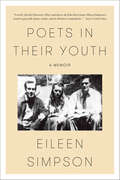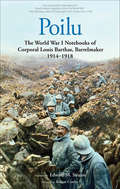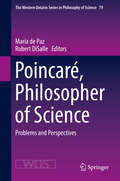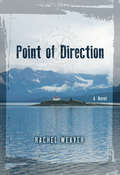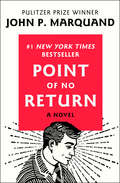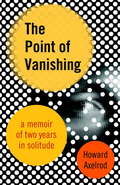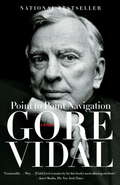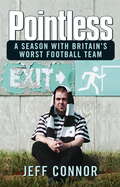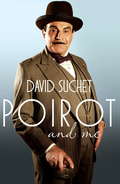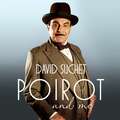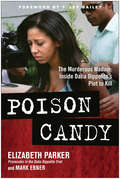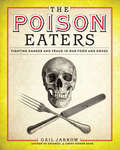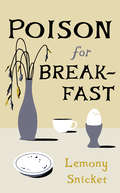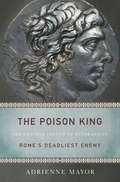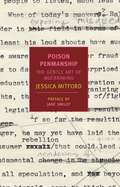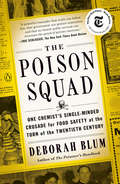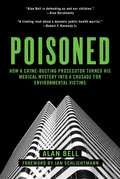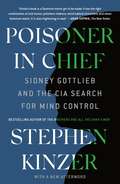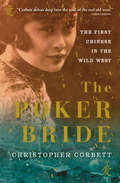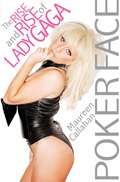- Table View
- List View
Poets in Their Youth: A Memoir
by Eileen SimpsonIn 1942, Eileen Simpson—then Eileen Mulligan—married John Berryman. Both were in their twenties; Eileen had just graduated from Hunter College and John had but one slim volume of poetry to his name. They moved frequently—from New York to Boston, then Princeton—chasing jobs, living simply, relying on the hospitality of more successful friends like Robert Lowell and Jean Stafford, or R. P. Blackmur and his wife, Helen. Rounding out their circle of intimates were other struggling poets like Randall Jarrell and Delmore Schwartz. Berryman alternately wrote and despaired of writing. Everyone stayed up late arguing about poetry.Poets in Their Youth is a portrait of their marriage, yes, but it is also a portrait of a group of spectacularly intelligent friends at a particular time, in a particular place, all aflame with literature. Simpson's recollections are so tender, her narrative so generous, it is almost possible to imagine the story has a different ending—even as Schwartz's marriage crumbles, as Lowell succumbs to a manic episode, as her own relationship with Berryman buckles under the strain of his drinking, his infidelity, his depression. Filled with winning anecdotes and moments of startling poignancy, Simpson's now classic memoir shows some of the most brilliant literary minds of the second half of the twentieth century at their brightest and most achingly human.
Poilu: The World War I Notebooks of Corporal Louis Barthas, Barrelmaker, 1914 – 1918
by Louis Barthas&“An exceptionally vivid memoir of a French soldier&’s experience of the First World War.&”—Max Hastings, New York Times bestselling author Along with millions of other Frenchmen, Louis Barthas, a thirty-five-year-old barrelmaker from a small wine-growing town, was conscripted to fight the Germans in the opening days of World War I. Corporal Barthas spent the next four years in near-ceaseless combat, wherever the French army fought its fiercest battles: Artois, Flanders, Champagne, Verdun, the Somme, the Argonne. First published in France in 1978, this excellent new translation brings Barthas&’ wartime writings to English-language readers for the first time. His notebooks and letters represent the quintessential memoir of a &“poilu,&” or &“hairy one,&” as the untidy, unshaven French infantryman of the fighting trenches was familiarly known. Upon Barthas&’ return home in 1919, he painstakingly transcribed his day-to-day writings into nineteen notebooks, preserving not only his own story but also the larger story of the unnumbered soldiers who never returned. Recounting bloody battles and endless exhaustion, the deaths of comrades, the infuriating incompetence and tyranny of his own officers, Barthas also describes spontaneous acts of camaraderie between French poilus and their German foes in trenches just a few paces apart. An eloquent witness and keen observer, Barthas takes his readers directly into the heart of the Great War. &“This is clearly one of the most readable and indispensable accounts of the death of the glory of war.&”—The Daily Beast (&“Hot Reads&”)
Poincaré, Philosopher of Science
by María De Paz Robert DisalleThis volume presents a selection of papers from the Poincaré Project of the Center for the Philosophy of Science, University of Lisbon, bringing together an international group of scholars with new assessments of Henri Poincaré's philosophy of science--both its historical impact on the foundations of science and mathematics, and its relevance to contemporary philosophical inquiry. The work of Poincaré (1854-1912) extends over many fields within mathematics and mathematical physics. But his scientific work was inseparable from his groundbreaking philosophical reflections, and the scientific ferment in which he participated was inseparable from the philosophical controversies in which he played a pre-eminent part. The subsequent history of the mathematical sciences was profoundly influenced by Poincaré's philosophical analyses of the relations between and among mathematics, logic, and physics, and, more generally, the relations between formal structures and the world of experience. The papers in this collection illuminate Poincaré's place within his own historical context as well as the implications of his work for ours.
Point Last Seen
by Hannah NyalaThis is a true story about a woman who, after escaping the brutality and violence of an abusive marriage, becomes a tracker with search-and-rescue teams in the Mojave Desert.
Point Man: Inside the Toughest and Most Deadly Unit in Vietnam by a Founding Member of the Elite Navy SEALs
by James Watson Kevin DockeryChief Petty Officer James "Patches" Watson was there at the start. One of the first to come out of the famed Underwater Demolition Team 21, he was an initial member -- a "plank owner" -- of America's deadliest and most elite fighting force, the U.S. Navy SEALs. Through three tours in the jungle hell of Vietnam, he walked the point -- staying alert to trip wires, booby traps and punji pits, guiding his squad of amphibious fighters on missions of rescue, reconnaissance and demolition --confronting a war's unique terrors head-on, unprotected ... and unafraid. This is the story of a hero told from the heart and from the gut -- an authentic tour of duty with one of the most legendary commandoes of the Vietnam War.
Point of Direction
by Rachel WeaverHitchhiking her way through Alaska, a young woman named Anna is picked up by Kyle, a fisherman. Anna and Kyle quickly fall for each other, as they are both adventurous, fiercely independent, and in love with the raw beauty and solitude of Alaska. To cement their relationship, they agree to become caretakers of a remote lighthouse perched on a small rock in the middle of a deep channel-a place that has been uninhabited since the last caretaker mysteriously disappeared two decades ago. What seems the perfect adventure for these two quickly unravels, as closely-held secrets pull them apart, and the surrounding waters threaten uncertain danger. A psychological thriller set against the rugged landscape of coastal Alaska, Point of Direction is an exquisite literary debut.ction, was chosen to represent Naropa University in the Harcourt Brace Best New Voices in American Fiction contest for 2006, 2007, and 2008. Her work has been published in the Gettysburg Review, Blue Mesa Review, and the Ontario Review. She currently lives in Colorado.
Point of No Return: A Novel
by John P. MarquandConsidered by many critics to be John P. Marquand's finest novel, Point of No Return is the story of a modern businessman borne back by fate into yesteryear Raised in the small town of Clyde, Massachusetts, Charles Gray has worked long and hard to become a vice president at the privately owned Stuyvesant Bank in Manhattan. But at the most crucial moment of his career, when his focus should be on reading his boss's intentions and competing with his chief rival for the promotion, Charles finds himself hopelessly distracted by the past. Years ago, the Gray family was featured in Yankee Persepolis, a sociological study of Clyde. Charles, his sister, and their parents were classified as members of the "lower-upper class," the unspoken strains of their tenuous social status cast in stark black and white. A chance encounter with the author of the study floods Charles's thoughts with memories, and when a business matter compels him to make a trip to Clyde, it seems as if the Fates are conspiring to turn back the clock. As he reflects on the defining moments of his youth, Charles contends with one of the central mysteries of existence: how our lives can feel both predetermined and random at the same time. Published in 1949, Point of No Return is a brilliant study of character and place heralded by the New York Times as "further proof that its author is one of the most important living American novelists."
The Point of Vanishing
by Howard AxelrodInto the Wild meets Portrait of the Artist as a Young Man--a lyrical memoir of a life changed in an instant and of the perilous beauty of searching for identity in solitude On a clear May afternoon at the end of his junior year at Harvard, Howard Axelrod played a pick-up game of basketball. In a skirmish for a loose ball, a boy's finger hooked behind Axelrod's eyeball and left him permanently blinded in his right eye. A week later, he returned to the same dorm room, but to a different world. A world where nothing looked solid, where the distance between how people saw him and how he saw had widened into a gulf. Desperate for a sense of orientation he could trust, he retreated to a jerry-rigged house in the Vermont woods, where he lived without a computer or television, and largely without human contact, for two years. He needed to find, away from society's pressures and rush, a sense of meaning that couldn't be changed in an instant.From the Trade Paperback edition.ions of perception, time, identity, and meaning.From the Trade Paperback edition.
Point to Point Navigation: A Memoir, 1964 to 2006
by Gore VidalPOINT TO POINT NAVIGATION refers to a form of navigation Gore Vidal resorted to as a first mate in the navy during World War II. As he says, 'As I was writing this account of my life and times since PALIMPSEST, I felt as if I were again dealing with those capes and rocks in the Bering Sea that we had to navigate so often with a compass made inoperable by weather.' It is a beautifully apt analogy for the hazards eluded (mostly) during his eventful life. From his desks in Ravello and the Hollywood Hills, Gore Vidal travels in memory through the arenas of literature, television, film, theatre, politics, and international society, recounting achievements and defeats, friends and enemies made (and on a number of occasions lost). Among the gathering of notables to be found in these pages, Tennessee Williams, Eleanor Roosevelt, Orson Welles, Greta Garbo, and Francis Ford Coppola. Some of the book's most moving pages are devoted to the illness and death of his partner of five decades, Howard Austen, and indeed the book is, among other things, a meditation on mortality, written in the spirit of Montaigne.
Pointless
by Jeff ConnorThe inside, in-depth and indiscreet story of a season with Britain's worst football club, East Stirlingshire. The Shire are lucky if all eleven players make it to a game, they have an average home attendance at their dilapidated Firs Park ground of 200 and they ended the 2004/05 season bottom of the Scottish Third Division – for the third consecutive year. Granted access to all areas, Jeff Connor gets into the dressing room, the board room and the dug-out. But, above all, he gets into the spirit of the club. He began the season a scoffing cynic and finished it lost in admiration for one of the dottiest sporting institutions in Britain as the Shire attempted to reach the promised land; SECOND bottom of the Scottish Third Division. At times funny, sad, heart-warming and embarrassing, as events on and off the pitch unfold, Pointless is an unmissable insight into a unique football team
Pointless
by Jeff ConnorThe inside, in-depth and indiscreet story of a season with Britain's worst football club, East Stirlingshire. The Shire are lucky if all eleven players make it to a game, they have an average home attendance at their dilapidated Firs Park ground of 200 and they ended the 2004/05 season bottom of the Scottish Third Division – for the third consecutive year. Granted access to all areas, Jeff Connor gets into the dressing room, the board room and the dug-out. But, above all, he gets into the spirit of the club. He began the season a scoffing cynic and finished it lost in admiration for one of the dottiest sporting institutions in Britain as the Shire attempted to reach the promised land; SECOND bottom of the Scottish Third Division. At times funny, sad, heart-warming and embarrassing, as events on and off the pitch unfold, Pointless is an unmissable insight into a unique football team
Poirot and Me
by David SuchetFans of Murder on the Orient Express and all things Agatha Christie won't want to miss this charming memoir from David Suchet...In the summer of 2013 David Suchet filmed his final scenes as Hercule Poirot. After 24 years in the role, he played the character in every story that Agatha Christie wrote about him (bar one, deemed unfilmable) and felt it time to bid adieu to a role and a character that changed his life.In Poirot and Me, David Suchet tells the story of how he secured the part, with the blessing of Agatha Christie's daughter, and set himself the task of presenting the most authentic Poirot that had ever been filmed.David Suchet is uniquely placed to write the ultimate companion to one of the world's longest running television series. Peppered with anecdotes about filming, including many tales of the guest stars who have appeared over the years, the book is essential reading for Poirot fans all over the world.
Poirot and Me
by David SuchetFans of Murder on the Orient Express and all things Agatha Christie won't want to miss this charming memoir from David Suchet...In the summer of 2013 David Suchet filmed his final scenes as Hercule Poirot. After 24 years in the role, he played the character in every story that Agatha Christie wrote about him (bar one, deemed unfilmable) and felt it time to bid adieu to a role and a character that changed his life.In Poirot and Me, David Suchet tells the story of how he secured the part, with the blessing of Agatha Christie's daughter, and set himself the task of presenting the most authentic Poirot that had ever been filmed.David Suchet is uniquely placed to write the ultimate companion to one of the world's longest running television series. Peppered with anecdotes about filming, including many tales of the guest stars who have appeared over the years, the book is essential reading for Poirot fans all over the world.
Poirot and Me
by David SuchetIn the summer of 2013 David Suchet will film his final scenes as Hercule Poirot. After 24 years in the role, he will have played the character in every story that Agatha Christie wrote about him (bar one, deemed unfilmable) and he will bid adieu to a role and a character that have changed his life.In Poirot and Me, David Suchet tells the story of how he secured the part, with the blessing of Agatha Christie's daughter, and set himself the task of presenting the most authentic Poirot that had ever been filmed.David Suchet is uniquely placed to write the ultimate companion to one of the world's longest running television series. Peppered with anecdotes about filming, including many tales of the guest stars who have appeared over the years, the book is essential reading for Poirot fans all over the world.(P)2013 Headline Digital
Poison Candy: The Murderous Madam: Inside Dalia Dippolito's Plot to Kill
by Mark Ebner F. Lee Bailey Elizabeth ParkerIn August 2009, former madam Dalia Dippolito conspired with a hit man to arrange her ex-con husband's murder. Days later, it seemed as if all had gone according to plan. The beautiful, young Dalia came home from her health club to an elaborate crime scene, complete with yellow tape outlining her townhome and police milling about. When Sgt. Frank Ranzie of the Boynton Beach, Florida, police informed her of her husband Michael's apparent murder, the newlywed Dippolito can be seen on surveillance video collapsing into the cop's arms, like any loving wife would-or any wife who was pretending to be loving would. The only thing missing from her performance were actual tears.... And the only thing missing from the murder scene was an actual murder.Tipped off by one of Dalia's lovers, an undercover detective posing as a hit man met with Dalia to plot her husband's murder while his team planned, then staged the murder scenario-brazenly inviting the reality TV show Cops along for the ride. The Cops video went viral, sparking a media frenzy: twisted tales of illicit drugs, secret boyfriends, sex-for-hire, a cuckolded former con man, and the defense's ludicrous claim that the entire hit had been staged by the intended victim for reality TV fame.In Poison Candy, case prosecutor Elizabeth Parker teams with bestselling crime writer Mark Ebner take you behind and beyond the courtroom scenes with astonishing never-before-revealed facts, whipsaw plot twists, and exclusive photos and details far too lurid for the trial that led to 20 years in state prison for Dalia Dippolito.
The Poison Eaters: Fighting Danger And Fraud In Our Food And Drugs
by Gail JarrowFormaldehyde, borax, salicylic acid. Today, these chemicals are used in embalming fluids, cleaning supplies, and acne medications. But in 1900, they were routinely added to food that Americans ate from cans and jars.In 1900, products often weren't safe because unregulated, unethical companies added these and other chemicals to trick consumers into buying spoiled food or harmful medicines. Chemist Harvey Washington Wiley recognized these dangers and began a relentless thirty-year campaign to ensure that consumers could purchase safe food and drugs, eventually leading to the creation of the U.S. Food and Drug Administration, or FDA, a US governmental organization that now has a key role in addressing the COVID-19/Coronavirus pandemic gripping the world today. Acclaimed nonfiction and Sibert Honor winning author Gail Jarrow uncovers this intriguing history in her trademark style that makes the past enthrallingly relevant for today's young readers.Six starred reviews -- ★Booklist ★BCCB ★Kirkus Reviews ★Publishers Weekly ★School Library Connection ★Shelf AwarenessAn ALSC Notable Children's Book * A Washington Post Best Children's Book * NCTE Orbis Pictus Honor Book * A BCCB Blue Ribbon * A Kirkus Reviews Best Children's Book * A NSTA Outstanding Science Trade Book for Students K-12 * A Chicago Public Library Best Children's Book★ "Revolting and riveting in turns, Jarrow's masterfully crafted narrative will fundamentally alter how readers view their food.Though laced with toxins, this is anything but toxic." -- Kirkus Reviews, starred review
Poison for Breakfast
by Lemony SnicketWashington Post Bestseller A new stand-alone adventure—appropriate for all ages—by Lemony Snicket, one of the twenty-first century’s most beloved authors. In the years since this publishing house was founded, we have worked with an array of wondrous authors who have brought illuminating clarity to our bewildering world. Now, instead, we bring you Lemony Snicket. Over the course of his long and suspicious career, Mr. Snicket has investigated many things, including villainy, treachery, conspiracy, ennui, and various suspicious fires. In this book, he is investigating his own death. Poison for Breakfast is a different sort of book than others we have published, and from others you may have read. It is different from other books Mr. Snicket has written. It could be said to be a book of philosophy, something almost no one likes, but it is also a mystery, and many people claim to like those. Certainly Mr. Snicket didn’t relish the dreadful task of solving it, but he had no choice. It was put in front of him, right there, on his plate.
The Poison King: The Life and Legend of Mithradates, Rome's Deadliest Enemy
by Adrienne Mayor"Meticulous in its research, exciting in its narration, ambitious in its conception, "The Poison King" re-creates an era when much of the Mediterranean world rebelled against Rome. At the center of it all is the fascinating and frightening king who rallied the resistance: Mithradates. Mayor has written a terrific book. "--Barry Strauss, author of "The Spartacus War". "Adrienne Mayor's "The Poison King" is an intriguing and highly readable new biography of one of the most controversial figures of antiquity, Mithradates--ruthless Hellenistic king, genocidaire, terrorist, alchemist, implacable enemy of Rome. It is an important contribution to our understanding of the desperate measures some rulers were prepared to take to resist Rome's iron-fisted pursuit of empire."--R. Bruce Hitchner, Tufts University.
The Poison King: The Life and Legend of Mithradates, Rome's Deadliest Enemy
by Adrienne MayorA compelling biography of the legendary king, rebel, and poisoner who defied the Roman EmpireMachiavelli praised his military genius. European royalty sought out his secret elixir against poison. His life inspired Mozart's first opera, while for centuries poets and playwrights recited bloody, romantic tales of his victories, defeats, intrigues, concubines, and mysterious death. But until now no modern historian has recounted the full story of Mithradates, the ruthless king and visionary rebel who challenged the power of Rome in the first century BC. In this richly illustrated book—the first biography of Mithradates in fifty years—Adrienne Mayor combines a storyteller's gifts with the most recent archaeological and scientific discoveries to tell the tale of Mithradates as it has never been told before.The Poison King describes a life brimming with spectacle and excitement. Claiming Alexander the Great and Darius of Persia as ancestors, Mithradates inherited a wealthy Black Sea kingdom at age fourteen after his mother poisoned his father. He fled into exile and returned in triumph to become a ruler of superb intelligence and fierce ambition. Hailed as a savior by his followers and feared as a second Hannibal by his enemies, he envisioned a grand Eastern empire to rival Rome. After massacring eighty thousand Roman citizens in 88 BC, he seized Greece and modern-day Turkey. Fighting some of the most spectacular battles in ancient history, he dragged Rome into a long round of wars and threatened to invade Italy itself. His uncanny ability to elude capture and surge back after devastating losses unnerved the Romans, while his mastery of poisons allowed him to foil assassination attempts and eliminate rivals.The Poison King is a gripping account of one of Rome's most relentless but least understood foes.Some images inside the book are unavailable due to digital copyright restrictions.
Poison Penmanship: The Gentle Art of Muckraking
by Jessica Mitford Jane SmileyJessica Mitford was a member of one of England's most legendary families (among her sisters were the novelist Nancy Mitford and the current Duchess of Devonshire) and one of the great muckraking journalists of modern times. Leaving England for America, she pursued a career as an investigative reporter and unrepentant gadfly, publicizing not only the misdeeds of, most famously, the funeral business (The American Way of Death, a bestseller) and the prison business (Kind and Usual Punishment), but also of writing schools and weight-loss programs. Mitford's diligence, unfailing skepticism, and acid pen made her one of the great chroniclers of the mischief people get up to in the pursuit of profit and the name of good. Poison Penmanship collects seventeen of Mitford's finest pieces--about everything from crummy spas to network-TV censorship--and fills them out with the story of how she got the scoop and, no less fascinating, how the story developed after publication. The book is a delight to read: few journalists have ever been as funny as Mitford, or as gifted at getting around in those dark, cobwebbed corners where modern America fashions its shiny promises. It's also an unequaled and necessary manual of the fine art of investigative reporting.
The Poison Squad: One Chemist's Single-Minded Crusade for Food Safety at the Turn of the Twentieth Century
by Deborah BlumFrom Pulitzer Prize winner and New York Times-bestselling author Deborah Blum, the dramatic true story of how food was made safe in the United States and the heroes, led by the inimitable Dr. Harvey Washington Wiley, who fought for change <p><p> By the end of nineteenth century, food was dangerous. Lethal, even. "Milk" might contain formaldehyde, most often used to embalm corpses. Decaying meat was preserved with both salicylic acid, a pharmaceutical chemical, and borax, a compound first identified as a cleaning product. This was not by accident; food manufacturers had rushed to embrace the rise of industrial chemistry, and were knowingly selling harmful products. <p> Unchecked by government regulation, basic safety, or even labelling requirements, they put profit before the health of their customers. By some estimates, in New York City alone, thousands of children were killed by "embalmed milk" every year. Citizens--activists, journalists, scientists, and women's groups--began agitating for change. But even as protective measures were enacted in Europe, American corporations blocked even modest regulations. <p> Then, in 1883, Dr. Harvey Washington Wiley, a chemistry professor from Purdue University, was named chief chemist of the agriculture department, and the agency began methodically investigating food and drink fraud, even conducting shocking human tests on groups of young men who came to be known as, "The Poison Squad." Over the next thirty years, a titanic struggle took place, with the courageous and fascinating Dr. Wiley campaigning indefatigably for food safety and consumer protection. <p> Together with a gallant cast, including the muckraking reporter Upton Sinclair, whose fiction revealed the horrific truth about the Chicago stockyards; Fannie Farmer, then the most famous cookbook author in the country; and Henry J. Heinz, one of the few food producers who actively advocated for pure food, Dr. Wiley changed history. When the landmark 1906 Food and Drug Act was finally passed, it was known across the land, as "Dr. Wiley's Law." <p> Blum brings to life this timeless and hugely satisfying "David and Goliath" tale with righteous verve and style, driving home the moral imperative of confronting corporate greed and government corruption with a bracing clarity, which speaks resoundingly to the enormous social and political challenges we face today.
Poisoned: How a Crime-Busting Prosecutor Turned His Medical Mystery into a Crusade for Environmental Victims
by Alan Bell Jan SchlichtmannAfter years of prosecuting hard-core criminals, rising legal star Alan Bell took a private sector job in South Florida’s newest skyscraper. Suddenly, he suffered such bizarre medical symptoms, doctors suspected he’d been poisoned by the Mafia. Bell’s rapidly declining health forced him to flee his glamorous Miami life to a sterile “bubble” in the remote Arizona desert. As his career and marriage dissolved, Bell pursued medical treatments in a race against time, hoping to stay alive and raise his young daughter, his one desperate reason to keep going. He eventually discovered he wasn’t poisoned by a criminal, but by his office building. His search for a cure led him to discover the horrifying truth: his tragedy was just the tip of the iceberg. Millions of people fall ill and die each year because of toxic chemical exposures—without knowing they’re at risk. Stunned by what he discovered, Bell chose to fight back, turning his plight into an opportunity. Despite his precarious health, he began collaborating with scientists dedicated to raising awareness about this issue. Soon, he also found himself drawn back into the legal field, teaming up with top lawyers fighting for those who had already fallen ill. Both a riveting medical mystery and a cautionary tale, this book puts a human face on the hidden truths behind toxic dangers assaulting us in our everyday environments—and offers practical ways to protect ourselves and our children.
Poisoner in Chief: Sidney Gottlieb and the CIA Search for Mind Control
by Stephen KinzerThe bestselling author of All the Shah’s Men and The Brothers tells the astonishing story of the man who oversaw the CIA’s secret drug and mind-control experiments of the 1950s and ’60s.The visionary chemist Sidney Gottlieb was the CIA’s master magician and gentlehearted torturer—the agency’s “poisoner in chief.” As head of the MK-ULTRA mind control project, he directed brutal experiments at secret prisons on three continents. He made pills, powders, and potions that could kill or maim without a trace—including some intended for Fidel Castro and other foreign leaders. He paid prostitutes to lure clients to CIA-run bordellos, where they were secretly dosed with mind-altering drugs. His experiments spread LSD across the United States, making him a hidden godfather of the 1960s counterculture. For years he was the chief supplier of spy tools used by CIA officers around the world.Stephen Kinzer, author of groundbreaking books about U.S. clandestine operations, draws on new documentary research and original interviews to bring to life one of the most powerful unknown Americans of the twentieth century. Gottlieb’s reckless experiments on “expendable” human subjects destroyed many lives, yet he considered himself deeply spiritual. He lived in a remote cabin without running water, meditated, and rose before dawn to milk his goats.During his twenty-two years at the CIA, Gottlieb worked in the deepest secrecy. Only since his death has it become possible to piece together his astonishing career at the intersection of extreme science and covert action. Poisoner in Chief reveals him as a clandestine conjurer on an epic scale.
The Poker Bride: The First Chinese in the Wild West
by Christopher CorbettThis true story of a concubine and the Gold Rush years &“delves deep into the soul of the real old west&” (Erik Larson). &“Once the discovery of gold at Sutter&’s Mill launched our &‘national madness,&’ the population of California exploded. Tens of thousands of Chinese, lured by tales of a &‘golden mountain,&’ took passage across the Pacific. Among this massive influx were many young concubines who were expected to serve in the brothels sprouting up near the goldfields. One of them adopted the name of Polly Bemis, after an Idaho saloonkeeper, Charlie Bemis, won her in a poker game and married her. For decades the couple lived on an isolated, self-sufficient farm near the Salmon River in central Idaho. After her husband&’s death, Polly came down to a nearby town and gradually spoke of her experiences. Journalist Christopher Corbett movingly recounts Polly&’s story, integrating Polly&’s personal history into the broader picture of the history of the mass immigration of Chinese. As both a personal and social history, this is an admirable book.&” —Booklist &“A gorgeously written and brilliantly researched saga of America during the mad flush of its biggest Gold Rush. Christopher Corbett&’s genius is to anchor his larger story of Chinese immigration around a poor concubine named Polly. A tremendous achievement.&” —Douglas Brinkley &“Uses Bemis&’s story as a platform for a larger discussion about the hardships of the Chinese experience in the American West.&” —The Washington Post
Poker Face: The Rise and Rise of Lady Gaga
by Maureen CallahanIn just a two-year span, Stefani Germanotta, a struggling performer in New York's Lower East Side burlesque scene, has become the global demographic-smashing pop icon known as Lady Gaga. She is a once-in-a-decade artist, a gifted singer, composer, designer, and performance artist who mixes high and low culture, the avant-garde with the accessible, authenticity with artifice.Who is Lady Gaga? She is a twenty-five-year-old woman whose stage mantra--"I'm a free bitch!"--is the polar opposite of who she is offstage: isolated, insecure, and unable to be alone. She is an outrÉ artist who wanted to be a sensitive singer-songwriter. She is a woman who says no man can ever compete with her career, but who goes back and forth with the ex-boyfriend who said she was too ambitious. She claims not to care what people think, but spends her downtime online, reading what people have to say about her. She claims to be a con artist and utterly authentic. She is never less than compelling.Based on more than fifty original interviews with friends, employees, rivals, and music industry veterans, Poker Face is the first in-depth biography of the extraordinary cultural phenomenon that is Lady Gaga.
